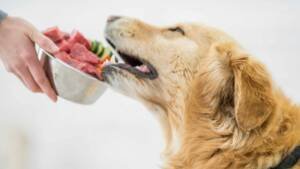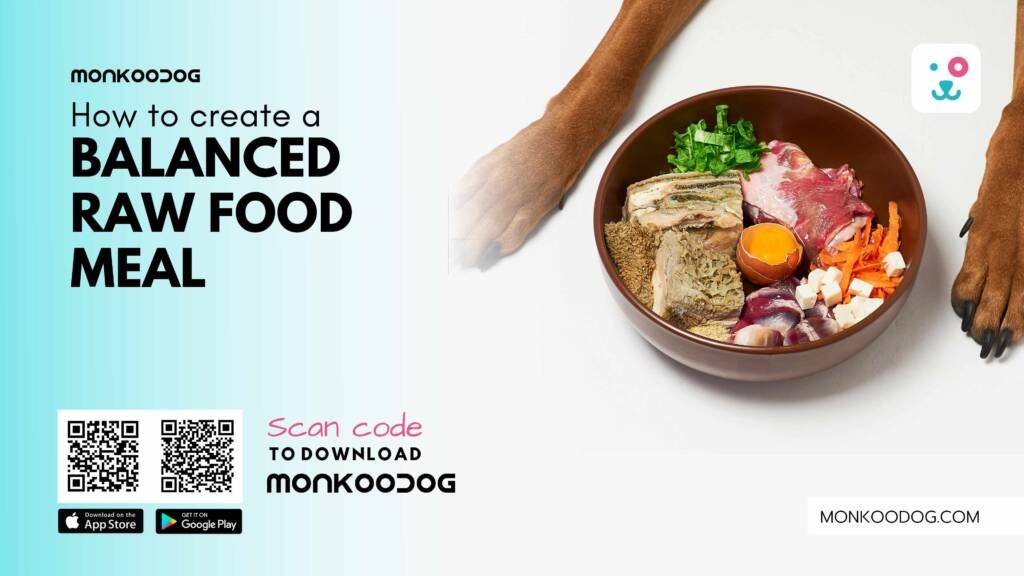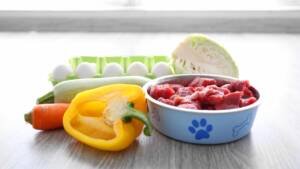Are you ready to transform your dog’s dinner bowl into a feast fit for a wolf? A balanced raw food diet is a great way to naturally nourish your furry friend, tapping into their ancestral roots and delivering a host of health benefits. From a shinier coat to improved digestion, a well-crafted balanced raw food meal can truly make a difference in your dog’s vitality. This guide will walk you through creating nutritious and balanced raw meals for your beloved pet.
Components of a Balanced Raw Food Meal
Just like people, dogs do best with a varied and well-balanced diet. A properly balanced raw meal is like a symphony of flavours and nutrients, with each ingredient playing a crucial part in your dog’s overall health and well-being. So, what exactly goes into crafting this culinary masterpiece? Let’s break it down:
- Meat: At the core of a raw meal is meat, which provides the essential protein needed for muscle growth and repair. Choose muscle meats like beef, chicken, turkey, lamb, or fish for a tasty and nutritious base. For some variety, you can also mix in less common options like duck, rabbit, or venison.
- Bones: Raw bones are crunchy and full of calcium, acting as nature’s toothbrush to keep your dog’s teeth clean while providing essential minerals. Choose raw meaty bones that are appropriately sized for your dog, such as chicken wings, necks, or backs.
- Offal: Often overlooked, organ meats like liver, kidney, and heart are nutritional powerhouses, packed with vitamins, minerals, and enzymes. Incorporate these in moderation for a well-rounded meal.
- Fruits and Vegetables: While not the main course, fruits and veggies offer fibre, vitamins, and antioxidants. Consider adding a colourful mix of options like berries, broccoli, carrots, and spinach.
- Supplements: In some cases, supplements might be necessary to ensure your dog receives all the nutrients they need. Talk to your veterinarian about potential supplements like fish oil, probiotics, or vitamin E.
If you’re just starting with raw feeding, a raw dog food feeding guide for beginners can be a valuable resource to help you navigate the basics and ensure your furry friend gets all the nutrients they need. Consulting with your veterinarian is also recommended before making significant changes to your dog’s diet.
Safe Handling and Preparation of Raw Food
Raw feeding doesn’t have to be a messy affair. With a few simple precautions, you can ensure your kitchen stays clean and your dog stays safe. Here’s how to handle raw food with confidence:
- Wash Thoroughly: Before and after handling raw meat, make sure to wash your hands with hot, soapy water for at least 20 seconds. This practice is essential to prevent the spread of bacteria.
- Separate Surfaces: Use a dedicated cutting board and utensils for raw meat to avoid cross-contamination with other foods. Consider using colour-coded tools to make it easy to differentiate.
- Sanitize Surfaces: After preparing raw food, clean all surfaces, including countertops and sinks, with a pet-safe disinfectant. This helps eliminate any lingering bacteria.
- Safe Storage: Store raw meat in airtight containers on the bottom shelf of your refrigerator to prevent drips and spills. Ensure raw meat is kept separate from other foods to prevent cross-contamination.
- Thaw Safely: Thaw frozen meat in the refrigerator overnight, not on the countertop. This helps maintain food safety and prevent bacterial growth.
- Serve Fresh: Serve raw meals immediately after preparation, and discard any uneaten portions after a reasonable amount of time. Avoid leaving raw food out for extended periods, especially in warm temperatures.
Looking for the best Pet Care App? Click to Download the App Now!
Transitioning to Balanced Raw Food Meal
To give your dog’s tummy time to adjust, it’s best to introduce a raw food diet slowly and steadily. Here is a sample plan to transition your pet to raw feeding:
- Week 1: Start by adding a sprinkle of raw food (10-25%) to your dog’s usual meal. As they get used to it, gradually increase the raw portion and decrease their regular food.
- Week 2: Increase the ratio of raw food to 50%, continuing to reduce the other food. Monitor your dog for any digestive changes, such as loose stools or vomiting.
- Week 3: Further increase the raw food percentage to 75%. Your dog should be primarily eating raw meals now, with a small amount of their previous food mixed in.
- Week 4: Transition completely to a 100% raw food diet. Monitor your dog closely for any signs of discomfort and make adjustments to the diet as necessary.
Throughout the transition, keep a close eye on your dog’s poop. It should be firm and well-formed. If you notice any significant changes, such as diarrhoea or constipation, adjust the ratio of raw to regular food accordingly. It’s also important to monitor your dog’s overall energy level, coat condition, and weight.

Recognizing the Signs of a Balanced Diet
Just like a well-tuned engine, a dog thriving on a balanced raw diet will exhibit a symphony of positive signs. Here’s what to look for:
- Vibrant Energy: A well-nourished dog will have plenty of energy for playtime and walks, without experiencing dramatic highs and lows.
- Shiny Coat and Healthy Skin: A balanced diet rich in essential fatty acids promotes a glossy coat and supple skin, free from excessive shedding or itchiness.
- Bright Eyes and Clean Teeth: Clear, bright eyes and clean teeth are indicators of good overall health and a well-functioning immune system.
- Healthy Weight and Muscle Tone: A balanced diet supports a healthy weight and lean muscle mass, helping your dog maintain a fit and active lifestyle.
- Consistent Poop: Well-formed, firm stools indicate proper digestion and nutrient absorption.
By monitoring your dog’s health, you can ensure they continue to thrive on a balanced raw food diet and enjoy a long and happy life.
Final Words
Raw feeding is a journey of discovery, and every dog is unique. By staying informed, observing your dog’s individual needs, and seeking guidance from your veterinarian, you can create a personalised meal plan that supports their overall well-being. Your furry friend’s tail wags and healthy glow will be your ultimate reward.


